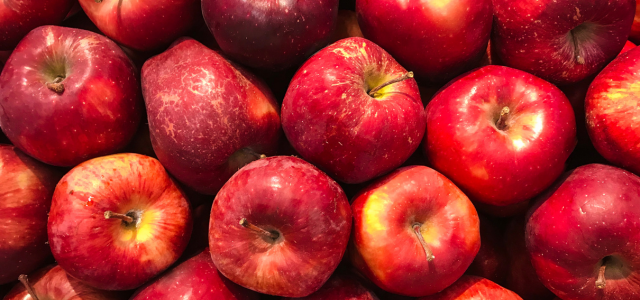For over a century, the Fruit Union Suisse (“FUS”), one of the oldest fruit farmers organizations in Switzerland, has been representing Swiss fruit growers and advocating for their interests.
The FUS displays a logo featuring a red apple adorned with a white cross, symbolizing the Swiss national flag.
However, there is the potential of legal uncertainty looming over the FUS shoulders.
In fact, Apple Inc. (“Apple”), the world-famous tech giant, is looking to obtain a trademark of a generic image of an apple fruit in Switzerland for years now.
Depending on the final outcome of this trademark application, the FUS may be forced to change its logo to avoid exposure to possible trademark infringement claims.
To better understand this story, let’s first analyze the FUS and Apple logos.
Fruit Union Suisse Logo
The FUS logo is essentially made up of an apple and the Swiss flag.
As its central element, the FUS logo features a vibrant red apple fruit.
This red apple fruit has a smooth and rounded shape representing the fruit that is cultivated by Swiss farmers.
On the image of the apple itself, you will find a distinctive white cross on the right side of the apple.
The cross represents the Swiss national flag, appearing in white on the red background.
Apple’s Logo
On the other hand, Apple’s logo is one of the most recognizable brands in the world.
In the Apple logo, you have the depiction of an apple fruit in a solid color, usually black or silver, against a clean, white background.
The apple also has a smooth and rounded shape just like the FUS logo, resembling a real apple fruit.
The most distinctive feature in Apple’s logo is the bite taken out of the right side of the fruit, creating a small curve or notch.
Apple’s Trademark Application in Switzerland
Since 2017, Apple has been on a mission to secure exclusive rights over the depiction of the generic image of an apple fruit in Switzerland.
More specifically, Apple is trying to obtain a trademark for a black-and-white image of an apple that appears like the Granny Smith variety.
In its trademark application, Apple offers a list of various uses for this image in the digital and electronic consumer goods, among others, which aligns with Apple’s core business model.
Trademark Application Denial
After many years of back and forth, the Swiss Institute of Intellectual Property ultimately rejected Apple’s application with respect to the trademark on the generic image of an apple fruit.
The idea behind the denial is that the depiction of an apple fruit, essentially a common good, must remain in the public domain.
However, Apple does not agree.
Apple filed an appeal against the Swiss Institute of Intellectual Property’s decision hoping to overturn the same.
Apple’s Global Trademark Strategy
According to the World Intellectual Property Organization records, as reported by Wired, Apple has pursued a similar trademark application strategy in various jurisdictions around the world.
Although in most jurisdictions Apple was not able to secure its desired trademark, they did succeed in a few, namely, Japan, Turkey, Israel, and Armenia.
For all the other jurisdictions, Apple has not been able to successfully secure the trademark it has in sight.
Takeaways
Trademarks are incredibly useful in granting companies monopoly over a particular image or logo.
From this point of view, Apple’s trademark application could not be viewed as fundamentally flawed.
However, the real question is whether it is reasonable for Apple to secure a trademark on a generic image of an apple, albeit within the digital and consumer goods categories?
As an initial factual premise, we must recognize that the apple fruit is a common good available to all around the world.
Furthermore, the generic image of an apple is depicted in countless ways in history and in modern times, particularly in arts, shows, and movies, but also in business.
Now, by granting Apple exclusive rights over the generic image of an apple, the perverse outcome is that countless individuals and companies could be exposed to potential infringement claims merely by using the generic image of an apple.
This cannot be a fair outcome for society as a whole.
Another way to frame our analysis is to ask if consumers may potentially confuse Apple’s depiction of an apple fruit with FUS logo or that of others?
From this perspective, a prima facie analysis leads us to conclude that it may be unlikely for a consumer to confuse Apple’s depiction of an apple with that of FUS’s logo.
Ultimately, the intellectual property authorities in each jurisdiction dealing with this type of trademark application should exercise caution to balance Apple’s legitimate interest in protecting Apple’s trademarks and the general public’s right to use the generic image of an apple without risk of legal peril.
You may also like…
INTA files statement in intervention in EU case on the inherent distinctiveness of color combination trademarks
New York, New York—July 24, 2024—The International Trademark Association (INTA) has filed a Statement in...
Bytedance stumbles in Singapore: IPOS rejects TIKI trademark challenge
The social media giant Bytedance, owner of the ubiquitous TikTok platform, recently suffered a setback in Singapore....
TOUR DE FRANCE fails in the third stage against German fitness studio chain
At the end of June, the 111th edition of the Tour de France kicked off. June also saw the end of a dispute between...
Contact us to write for out Newsletter















